Acreman Family Murders: Horror in the Florida Countryside
The Acreman Family murders shook the small town of Allentown, Florida. Nine members of the family died in their house, which was then set on fire. Could they be linked to other axe murders in 1906?

Around 10:00 am on the morning of May 14, 1906, in the tiny Allentown community of northwestern Florida, a man looked outside his window and realized he could no longer see his neighbor’s house. His neighbor, W.G. Acreman, lived on a tenant farm about a quarter mile away. He was married with seven children.
The man, who was not named in newspaper reports, rounded up other neighbors, and they rushed over as quickly as possible to see what was going on. The house was, just as he thought, gone. It had been burned nearly to the ground. The foundation was still burning when neighbors arrived. The rest of the home was in smoldering ruins.
One of the neighbors went to a nearby turpentine camp to phone for help. The county sheriff, the local doctor, and a judge headed to the scene from Milton, about 10 miles away.
Acreman Family Murdered in their Home
At the scene, neighbors and authorities found devastation and carnage. The entire family was dead, all nine of them. No one had been spared, not even the three-day-old infant. The fire had burned for several hours before being discovered. All of the bodies were badly burned, with the earliest reports describing them as being dismembered. The bodies of W.G. and Amanda seemed to be the most damaged, with papers describing them as only having the “trunk” remaining.

According to author Richard Wood, William Glenn (W.G.) Acreman was most likely born in 1869 in Lowndes County, Alabama, to father Zebulon Rudolph Acreman. He had eight brothers and one sister. Wood found that Acreman had been married at least three times at the time of his death. He married Timathea Nipper in Escambia County, Alabama, on Feb 5, 1893. It’s unclear what happened with this marriage. He then married Mary Simmons of Brewton, Alabama, in 1900. They had a daughter together. She was staying with family in Selma, Alabama, at the time of the murders. Acreman’s last wife was Amanda Sorrells. She was the daughter of David and Lizzie Sorrells.
W.G. would have been around 37 at the time of his death. His wife, Amanda was between 38-39. Their seven children ranged in age from just 3 days old to 14 years, with the eldest being a girl. Among them were four boys and two girls. The infant’s gender was not specified. Unfortunately, their names have all been lost to history.

Who was The Acreman Family?
Acreman was an itinerant preacher. It doesn’t seem he ever had a church home. He would preach wherever he could. He was described as a “most peaceful and harmless man who had great faith in his religion.” 1Pensacola News Journal 1906 He was also described as eccentric with no enemies. The family lived in Mobile, Alabama, in 1902. According to reports, the Acreman family was very poor and relied on help from charitable organizations and churches while living in Mobile. They moved approximately 140 miles away to Opp, Alabama, in 1903. Nothing is known about their time there. The family then moved to Allentown in Santa Rosa County, Florida, where they would be brutally murdered.
Sharecropping and Tenant Farms
W.G. Acreman worked as a sharecropper. A sharecropper was a farmer who worked land owned by someone else in exchange for a portion of the crops they produced, rather than a fixed wage. This system primarily existed in the South, following the Civil War and the abolition of slavery. Landowners, occasionally former plantation owners, provided the land, tools, and seeds for a fee, while the sharecroppers provided the labor.
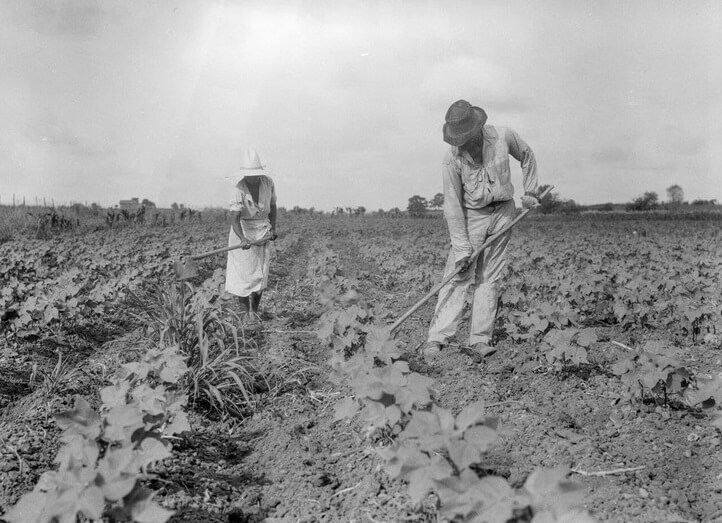
The sharecropping arrangement often resulted in a cycle of debt, as sharecroppers were required to buy supplies on credit from landowners or local merchants. However, with high interest rates and crop failures, many sharecroppers found themselves trapped in a system designed for exactly that.
The landowners often provided housing called “tenant houses.” These homes were often very basic and sometimes poorly maintained. The house was another thing the sharecropper would pay the landowner for. The tenant house the Acreman family lived in was a simple two-room house; there were two doors at the front, one leading into each room, and doors opposite the front doors leading out onto a back porch.
Acreman Family Home
The family’s sleeping arrangements were reported in the Pensacola News Journal. It is unclear how they obtained this information as the entire family were killed and their bodies badly burned. Regardless, the arrangements were reported as such:
In the east room, W.G. shared a bed with one of his sons. Amanda and the infant occupied a bed directly opposite them. In the west room, the other three sons shared a bed. The two daughters shared a bed directly opposite them.

Mr. Acreman’s remains were found lying in a doorway leading to the rear porch. Beside him lay the burnt remains of a gun. It was speculated that Mr. Acreman knew his family was in trouble and tried to protect them as best he could. Amanda Acreman’s body, along with that of their three-day-old infant, was found outside, in the front doorway.
The three sons who slept in the west room were all found in the bedroom; the location of the bodies seemed to indicate that the boys had all been killed in bed. The location of the other son’s body, who slept in the room with his parents, was not noted. It is possible that Mr. Acreman heard a noise and sent his son to check the other room while he armed himself.
The eldest daughter was found just inside of the doorway, leading to the front porch. The other daughter’s remains were found where her bed had once stood, before the fire. The locations of Mrs. Acreman and the oldest daughter seemed to indicate that they tried to flee the murderer.
Fire and Death
During the autopsies, authorities discovered that Mr. Acreman’s skull showed a large blood clot at the base of his brain, indicating blunt force trauma, such as with the blunt end of an axe or similar weapon. The skull belonging to Amanda Acreman showed the same trauma. Authorities determined that each family member had been killed in the same way, and they had all died before the fire was set. It’s unknown if the bodies were actually dismembered, severely burned, or both.
There was a high northwest wind blowing at the time of the fire, and cinders were found half a mile from the site. Investigators estimated that the fire was set around midnight, about 10 hours before the neighbor noticed. Questions arose at the time as to how no one saw the fire earlier, but no answers ever came. Tenant houses were often constructed entirely out of wood, while the foundation was made of brick or stone.
Small Town Policing
Today Allentown is a census-designated community located in Santa Rosa County in northwestern Florida. It’s located in the Pensacola metro area. In 1906, Allentown was a “quiet rural area of indefinite dimensions.” 2James, Bill. The Man from the Train. Since Allentown wasn’t really a city, they didn’t have city resources such as police. They would’ve depended upon the county. In those days, rural police forces consisted of a few men with very little training and resources. They would have been totally out of their depths trying to investigate a mass murder. In some instances, “They would talk to the neighbors, talk to the families, hassle a few local criminals, and then shrug their shoulders and put it aside.”3James, Bill. The Man from the Train.
Murder investigations in the early 1900s were rudimentary at best. Based on reporting, it does seem that authorities in the area tried their best with what they had. A reward amount of $2,300 was raised, $1,800 from the community and $500 was from then governor Napoleon B. Broward. That is over $80,000 in 2024 dollars, which is an impressive amount. Community members donated amounts ranging from $5 to $100.
A coroner’s inquest was quickly impaneled but would conclude without any real answers. No murder weapon was found, but it was said to be an axe. No one knows if the killer brought the axe with them or used one belonging to the family.
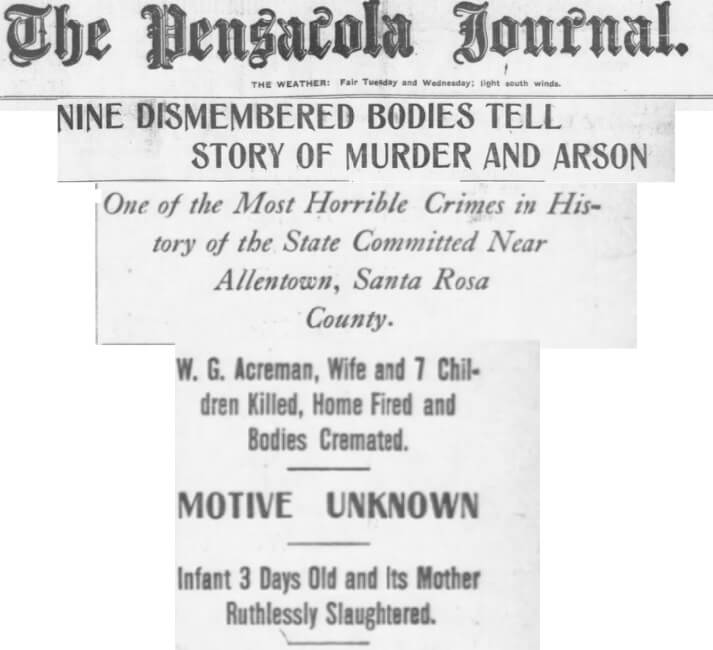
Questions and Arrests
I am certain that the rumor mill was ablaze in the small area. Who could’ve done this? Who could kill a baby? Why the Acreman family? One rumor was that someone from the nearby turpentine camp had killed the family. Another was that the killer had intended to steal from the family. The Acerman family was very poor; they couldn’t have had anything much to steal.
It is unknown how far away the landowner’s home was from the fields. The landowner that Acreman worked for was never named. It is unclear if he was ever considered a suspect in the murders.
Two men, Joe Stanley and William C. Smith, were arrested on May 7, 1907. Their relationship to the Acreman family is unknown, but they did testify at the coroner’s inquest before leaving the area. The preliminary trial was postponed on May 16, 1907. It doesn’t seem the matter was ever continued, as there are no records stating such. It’s unknown what ultimately happened to the reward money.
Mr. Acreman was known to carefully examine his shotgun on a nightly basis and then place it in the bed with him. This ritual was apparently “generally known in the neighborhood and frequently commented upon.” 4Montgomery Advisor 5/18/1906 Whether or not Mr. Acreman actually had any enemies remains a mystery. Was the family targeted, or were they victims of opportunity? Could the family have recognized their attacker(s)?
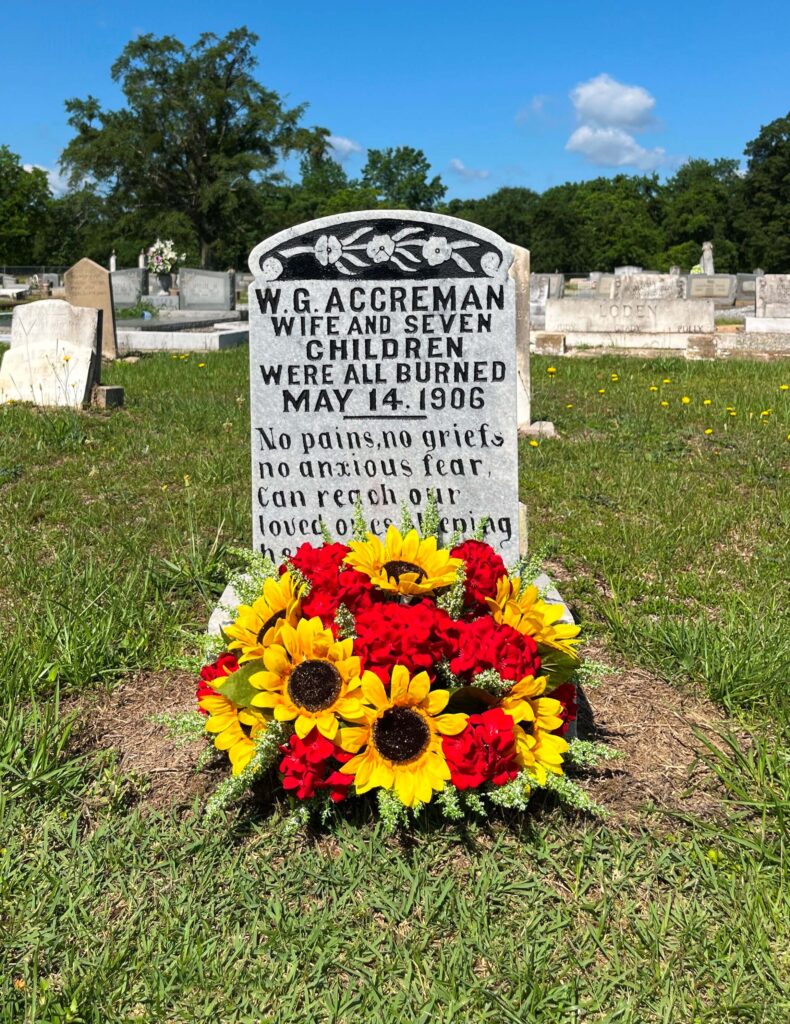
The Acreman family massacre remains the deadliest axe murder in the United States. We will never know what exactly happened to this family on that terrible night. What we do know is that the Acreman family was not the only victim of a family massacre such as this. They weren’t even the only victims that year.
Christmas Family Axe Murders
Three months earlier, 130 miles away in Cottonwood, Alabama, another family was found brutally murdered in their home. The Christmas family, J.M. Christmas, his wife Martha, and their young son Slocum, were all found dead in their home on February 8, 1906. Several people, including their oldest son, were arrested for the murders.
Lyerly Family Axe Murders
Six hundred miles away, two months after the Acreman family murders, five members of the Lyerly family were murdered in Barber Junction, North Carolina. Sometime during the night of July 14, 1906, Mr. Isaac Lyerly, 68, his wife Augusta, 43, their youngest daughter Alice, 6, and son Johnny, 9, were killed in their home. They were fatally wounded by blunt blows from an axe. The assailant then set fire to the Lyerly’s parent’s bed. Three older children, Mary (18), Janie (9), and Addie (13), were sleeping upstairs and were able to extinguish the flames before the home was totally destroyed.
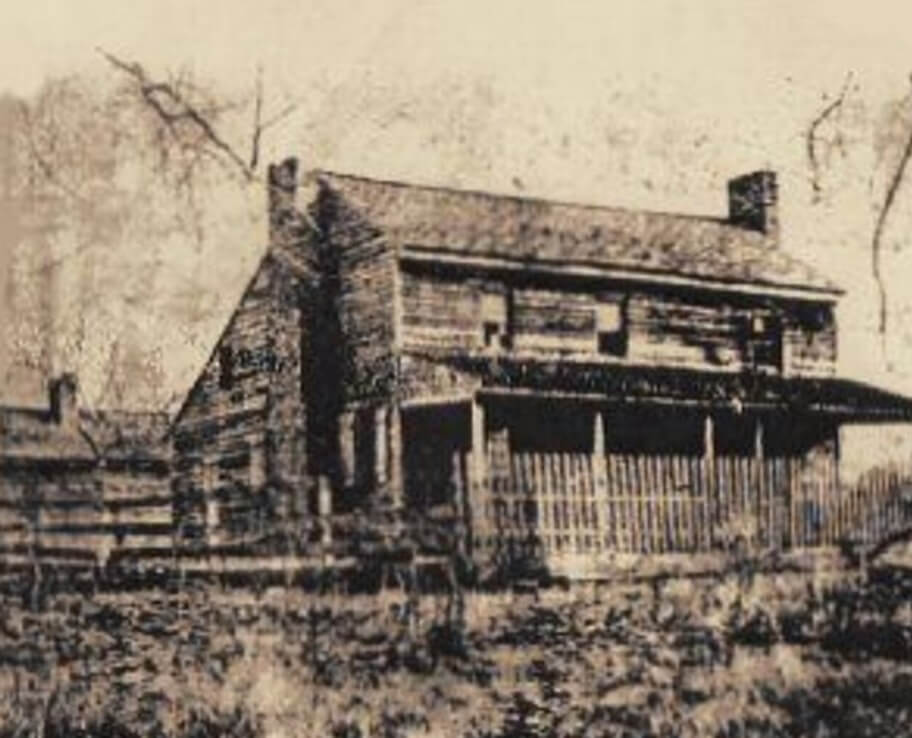
While the Lyerly’s family murders were tragic in their own right, what happened after was just as tragic. Six Black people, one woman and five men, were arrested without evidence. Nease Gillespie, his sons John Gillespie and Henry Lee, Jack Dillingham, his wife Della, and George Ervin. All six were sharecroppers on the Lyerly’s land. Three of the men, Nease Gillespie, John Gillespie, and Jack Dillingham, were lynched in an act of brutality that cannot be exaggerated. In August 2021, a marker remembering these horrific events was placed by a nonprofit group called the Equal Justice Initiative. It is placed at the Oak Grove-Freedman’s Cemetery near the corner of W. Liberty and N. Church Streets in Salisbury, North Carolina.
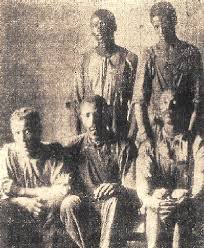
Jack Dillingham (seated L), Nease Gillespie (seated R), John Gillespie (standing R). Photo: Salisbury Post
The Lyerly Family axe murders remain unsolved.
Moore Family Axe Murders
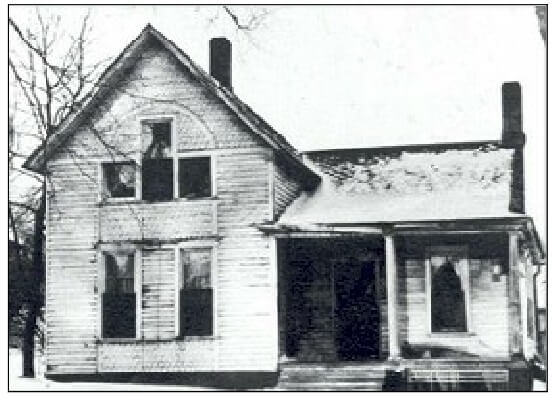
The most well-known family axe murder is the Villisca axe murders. On June 9, 1912, all six members of the Moore family, along with two visiting girls from the Stillinger family, were found brutally murdered in a Villisca, Iowa, farmhouse. The murder weapon belonged to the family. The victims were identified as Josiah Moore, 43; Sarah Moore, 39; Herman Moore, 11; Katherine Moore, 10; Boyd Moore, 7; and Paul Moore, 5. Lena Stillinger, 12, and Ina Stillinger, 8.
The victims all attended a program at the local Presbyterian Church that evening and returned home around 10 p.m. Their bodies were discovered the next morning. A neighbor noticed the family wasn’t outside doing their usual farm chores. The neighbors tried to get inside the home but were unable to. They called the town Marshall, the chief law enforcement officer of the town, a man named Henry “Hank” Horton. He broke down the door of the home and discovered the bodies. He told a Moore family relative, “Somebody was murdered in every bed.”
A plate of uneaten food and a bowl of bloody water were found in the kitchen. All of the mirrors and the glass in the front doors were all covered with pieces of clothing or bed sheets from the home. While a few people were suspected of the crime, including a state senator and local reverend, no one was ever tried or convicted for the murders. It remains unsolved.
The Man from the Train
In a 2017 book, The Man from the Train, baseball statistician Bill James and his daughter Rachel McCarthy James lay out their theory that a German immigrant named Paul Mueller is responsible for countless axe murders between 1900 and 1912. These include those of the Christmas, Acreman, and Lyerly families, as well as the massacre in Villisca.
They theorize that he would ride the trains, get off at sleepy little towns, and go searching for a family to kill, preferring a yard with an easily accessible axe. He would always strike at night, enter the home through the back door, often sexually assault the women and girls of the family, and use sheets and blankets from the home to cover the dead bodies of his victims. His motive was not to steal but just to kill. Sometimes he would remain at the home for several hours, until daybreak.
They theorize that Mueller killed people all across America and in his native Germany. All the while, innocent people were executed and lynched for his crimes. Paul Mueller disappeared into Germany after 1922. It is unknown whatever became of him.
Acreman Family Murders
Looking at the crime through a twenty-first century lens, it seems unfathomable that an entire family could be murdered and their names not even be reported. In researching this story, I attempted to find the names of the Acreman children, but was unable to. I reached out to the Santa Rosa County, Florida Historical Society but have yet to hear back.
Author’s Note: In researching this story, I found the family’s surname spelled like Ackerman, Acreman, Akreman, and Accreman. I chose to use Acreman, which was the spelling used in most contemporaneous reports.
Sources:
Jury Still Out in Acreman Trial. Pensacola News Journal. 17 May 1906.
Nine Dismembered Bodies Tell Story of Murder and Arson. The Pensacola Journal. 15 May 1906.
Some Awful Crimes in West Florida. Live Oak Democrat. 19 May 1906.
Case is Continued. The Montgomery Advertiser. 17 May 1907.
Murder of the Ackermans. The Montgomery Advertiser. 18 May 1906.
The Axe-idental Tourist. Notes from The Frontier. 11 May 2023.
Wood, Richard. Judging Shadows. 11, August 2017.
1912 Axe Murders in Villisca Remain Unsolved. Iowa State Capital Tour Guide. 13, May 2015.
Five Murdered in North Carolina Town. The Evening Tribune. 14, July 1906.
Murderous Hands deal Death Blows to Four of this Family. The Hickory Democrat. 19 July 1906.
August 7, 1906: 3 Black Men Hung For Suspected Murder of NC Landowners. WFMY News. 07 August 2016.
Smithsonian Magazine: The Axe Man
Legends of America: The Ax Man
Featured Image is ‘Florida Sharecropper’s Shack’ by Bryan Katz, via Flickr.
- 1Pensacola News Journal 1906
- 2James, Bill. The Man from the Train.
- 3James, Bill. The Man from the Train.
- 4Montgomery Advisor 5/18/1906





